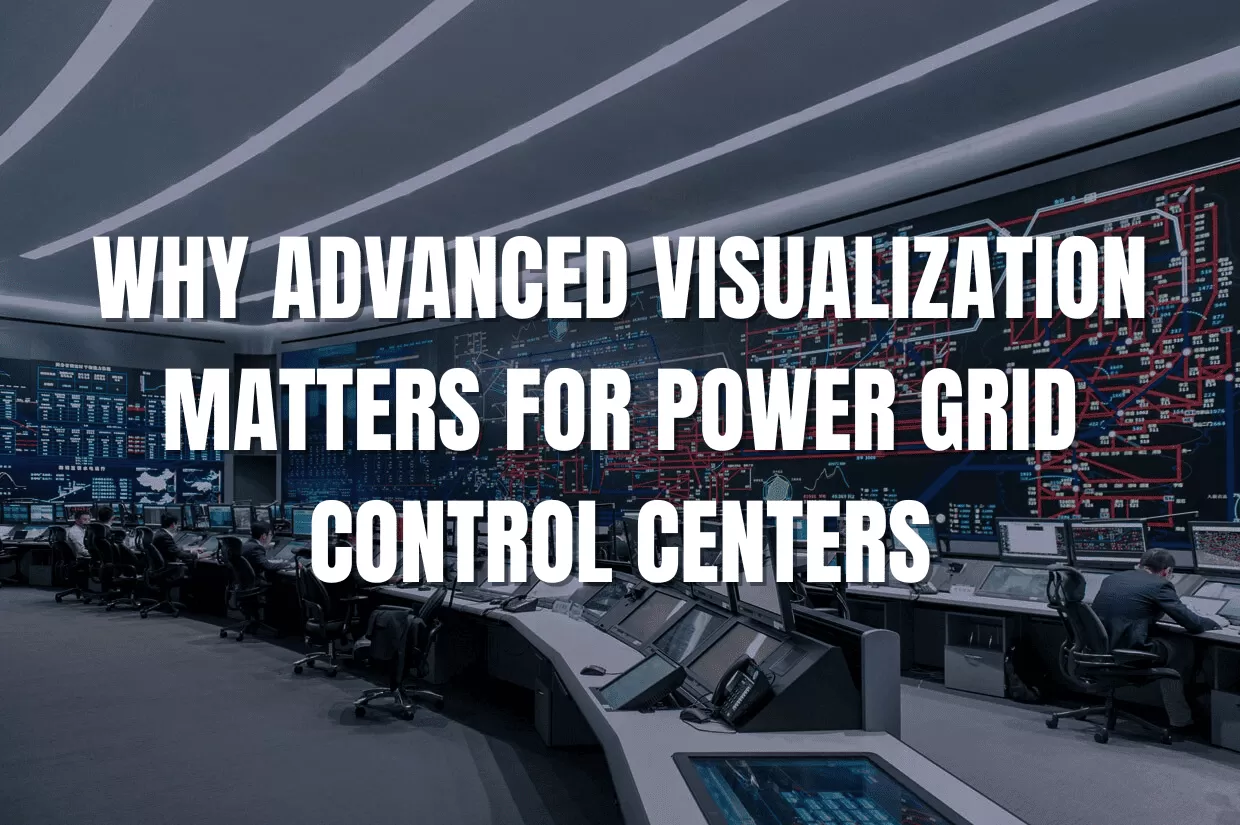Is grid stability a concern? Without clear sight, failures are a serious risk. Advanced visualization brings critical clarity to power grid control centers.
Advanced visualization solutions in power grid control centers integrate diverse data, display content efficiently, and use intuitive interfaces. This allows operators to monitor grid health, detect anomalies, and make quick decisions, preventing outages and ensuring stability.

Understanding these systems is complex. But learning about them matters for anyone involved. I will share how these tools truly improve operations. My experience shows a clear need for better information display.
Why Advanced Visualization Matters for Power Grid Control Centers
How Do Advanced Visualization Systems Enhance Operational Awareness?
Do operators struggle with overwhelming data streams? Missed signals lead to critical errors. Advanced visualization offers clarity, sharpening focus for faster responses.
These systems unify diverse data sources like SCADA, GIS, and weather onto a single display. Operators gain immediate, comprehensive situational awareness, enabling them to identify issues quickly, understand their impact, and proactively adjust to grid stability.

Control rooms process vast amounts of information. Power grids are not simple. They are large, complex networks. Operators need to see many things at once. This requires integrating various information sources. SCADA systems, weather reports, and GIS maps all show different parts of the situation. A sound visualization system brings these together onto large screens. This screen acts like a central hub for the operator. It helps them understand complex situations quickly. This reduces stress and potential mistakes. Clear visuals mean fewer errors and more confident actions by staff.
Consolidating Diverse Data Feeds
Managing a power grid without integrated visualization is like following many separate conversations simultaneously. Information comes from many sensors, substations, and control systems. Data arrives in many different formats. Advanced systems collect these varied data streams. They process them into a clear, unified format. They then show this information on shared screens. This stops operators from switching between many software programs. It dramatically reduces the mental effort required. It also lowers the chance of human mistakes under pressure. My work often involves integrating systems that seem unrelated. Making them work together visually is the key.
Visualizing Network Complexity and Flow
The power grid itself is an intricate, connected system. Showing this complexity visually is very important. Instead of just numbers, operators see comprehensive maps. They see how electricity is flowing. Areas that are overloaded or at risk become visible. This visual format makes network relationships easy to grasp. It helps find bottlenecks quickly. Understanding the physical status of the network is critical. A map showing real-time load distribution is much better than a simple list of numbers. It helps find and fix problems faster. This visual data aids faster troubleshooting and better resource planning by teams.
Alert Prioritization and Event Management
In a high-stress situation, knowing what needs the most attention is vital. These systems do more than display data. They highlight key events. Alarms can be shown with specific colors. They can flash to get attention. They can be placed in essential screen areas. This alerts operators to problems before they become significant issues. It means quickly detecting voltage drops, equipment faults, or potential overload situations. This proactive approach is crucial for managing the grid and preventing disruptions. It ensures that critical alerts are never missed.
What Makes Video Walls Reliable for Critical Infrastructure?
Grid failures cause widespread disruption. Can your systems handle constant demand? Reliability is essential when keeping power on.
True reliability comes from robust hardware, fault tolerance, and backup systems. Video walls are designed for 24/7 operation and use high-quality components. They ensure the continuous display of critical information. This prevents data loss or interruptions even if system parts fail.

Power grids operate without stopping, 24 hours a day, seven days a week. The technology that supports them must do the same. Reliability is not just a feature; it is a fundamental requirement. Any downtime on the visualization system for vital infrastructure like power grids can lead to significant problems. This can affect many people and services.
Built for Continuous Operation
The physical components of a video wall must be very durable. They need to be built to last. This includes high-quality screens designed for constant use, often rated for 24/7 operation. It means strong frames and advanced cooling systems to prevent overheating. Components must handle the harsh environment of a control center. These centers often run nonstop. Durable components directly help meet the need for systems that operate smoothly all the time. They minimize unexpected failures that could cause bigger problems. My involvement with critical systems always starts with ensuring the basic hardware is top-notch.
System Architecture with Redundancy
What happens if one part of the system stops working? For crucial operations, backup plans are a must. Redundancy means having backup power supplies. It means backup video controllers. It can even mean backup network connections. If a main component fails, a backup one takes over quickly. This switch should happen smoothly. It should show no interruption on the screen. This ensures operators never lose sight of critical grid status. This is true even if a hardware issue or power surge affects part of the setup. It builds layers of safety and strength into the system.
Long-Term Maintainability and Support
Reliability also depends on how easily the system can be kept working. Complex systems can be complicated to fix when problems happen. Companies must focus on making products that are simple to operate and maintain. When a component needs fixing or changing, it should be straightforward. Quick access to technical help and available replacement parts are also critical. This reduces downtime. It ensures the system stays operational for a long time. This reduces the difficulty for integration teams. It shows commitment from the manufacturer throughout the product's life.
Why Should System Integrators Choose Solutions Focused on Simplicity and Trust?
Are you concerned about unreliable technology and difficult partnerships? Building trust goes beyond features. It requires a strong promise of quality and support.
Companies focused on making advanced video wall technology simple, reliable, and easy to operate directly help system integrators. They reduce installation complexity. They lower the number of support requests. They ensure client satisfaction with strong, user-friendly systems.

Building a reliable video wall system for a power grid is a big job. It involves not just technology. It also requires deep trust. My experience shows how vital trust is. The drive to prove the capability of technologically advanced products from its origin stems from a shared understanding within the industry. Early market perceptions could create hesitations. This led to a mission focused on building a company that consistently demonstrates quality and reliability on a global scale. The aim is to show that advanced technology can compete and excel internationally.
Commitment to Quality and Performance
Selecting components that meet high standards is mandatory for system integrators working on critical projects. They need products that will not fail them when working on important projects for command centers or transportation hubs. Elevating the reputation of technological origin means prioritizing quality and innovation at every stage. This involves investing in research and development. It requires strict quality control at every step of production. This commitment ensures products not only compete but perform well globally. It offers the confidence and dependability that critical infrastructure needs.
Ease of Operation and Integration
We understand the difficulties that AV system integrators face. Coordinating many suppliers, managing complex project schedules, and ensuring long-term system performance are constant worries. The aim is to be more than just a supplier. The goal is to be a trusted partner. Providing products that are naturally easy to use and robust simplifies the integration process. This reduces potential failure points. It lessens the support needed for project managers and engineers. The objective is to contribute to successful deployments. The video wall system should become a base of trust and operational excellence for clients everywhere.
What Future Innovations Will Transform Power Grid Visualization?
Is the current visualization keeping up with grid changes? The future needs smarter, prediction-based systems. New technologies promise more insight and control.
Future innovations include AI-driven predictive analysis, better AR/VR for maintenance, and IoT sensor integration. These advances will enable proactive grid management, more efficient fault detection, and optimized energy distribution.

The field of power grid management is constantly changing. What works now may not be enough for tomorrow's challenges. Innovation is key to staying ahead. We are moving beyond just showing data to predicting and preventing issues. Exciting technological developments drive this shift. They promise to change grid operations and make systems more resilient.
Artificial Intelligence and Predictive Analysis
Artificial intelligence (AI) is set to become a major driver of change. AI programs can analyze vast amounts of historical and current data. They can find patterns that people might not see. This allows for predictive maintenance. It means forecasting potential equipment failures well before they happen. Machine learning models can also predict demand changes more accurately. This helps operators optimize energy generation and distribution. This can improve grid stability and efficiency. Imagine systems that warn you about a problem days in advance. This optimizes resource use significantly.
The Impact of IoT and Edge Computing
The 'Internet of Things' (IoT) is digitally expanding the grid's reach. More sensors are being added across the network. These sensors generate massive amounts of data. Managing and processing this data effectively needs advanced solutions. Edge computing, where data is processed closer to where it is created, becomes very important. This reduces delays. It allows for faster responses in real-time grid control. Visualization systems must integrate and display insights from these distributed IoT networks. They must provide a complete view of the system. As IoT grows, system security also becomes a very important factor.
Augmented and Virtual Reality Applications
New technologies like Augmented Reality (AR) and Virtual Reality (VR) offer new ways to interact with grid data and infrastructure. AR can place real-time operational data directly onto physical equipment during maintenance or inspections. This gives field technicians important information. It appears directly in their line of sight. This improves how accurately they can diagnose issues. VR could be used for advanced training simulations. It allows operators to practice responding to different emergencies in a safe, virtual space. These immersive tools can significantly improve understanding and readiness.
Conclusion
Advanced visualization transforms power grid control. It ensures clarity, reliability, and efficient operation. This empowers operators to safeguard our essential energy networks.





